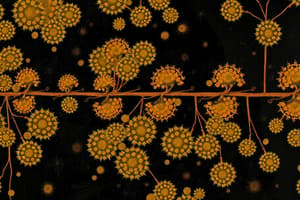Podcast
Questions and Answers
Wie wird die Transkription in einem Operon gestoppt?
Wie wird die Transkription in einem Operon gestoppt?
- Die Repressoren binden an die Effektormoleküle und verhindern die Bindung an den Operator. (correct)
- Die Aktivatoren binden an den Operator und blockieren die RNA-Polymerase.
- DNA-Bindungsproteine verändern die Struktur der RNA-Polymerase.
- Post-transkriptionale Regulation beeinflusst direkt die RNA-Polymerase.
Was ist die Rolle von Aktivatoren in der Transkription?
Was ist die Rolle von Aktivatoren in der Transkription?
- Sie binden an den Operator und unterdrücken die Transkription.
- Sie erhöhen die Affinität der RNA-Polymerase für den Promotorbereich. (correct)
- Sie blockieren die mRNA-Stabilität.
- Sie beeinflussen die Post-Transkription.
Welches ist ein charakteristisches Merkmal der post-transkriptionalen Regulation in Prokaryoten?
Welches ist ein charakteristisches Merkmal der post-transkriptionalen Regulation in Prokaryoten?
- mRNA-Stabilität und Ribosomenbindungsstellen-Auswahl (correct)
- RNA-Polymerase-Aktivität und Promotorbindung
- Genexpression und Transkriptionsrate
- DNA-Bindungsproteine und Operatoren
Was bewirkt ein DNA-Bindungsprotein wie der Lac-Repressor?
Was bewirkt ein DNA-Bindungsprotein wie der Lac-Repressor?
Welche Bedeutung haben DNA-Bindungsproteine für die Transkriptionsregulation bei Prokaryoten?
Welche Bedeutung haben DNA-Bindungsproteine für die Transkriptionsregulation bei Prokaryoten?
Flashcards are hidden until you start studying
Study Notes
Gene Regulation in Prokaryotes
Prokaryotic organisms, including bacteria and archaea, employ diverse strategies to regulate their gene expression, ensuring that their DNA is translated into functional proteins only when necessary. Two primary modes of gene regulation in prokaryotes are transcriptional and post-transcriptional, which we'll explore along with the operon model and DNA binding proteins.
Operon Model
In the 1960s, François Jacob and Jacques Monod proposed the operon model to explain how prokaryotes regulate multiple genes in a coordinated manner. According to this model, a group of functionally related genes is clustered together and regulated by a single operator site, transcribed as a single polycistronic mRNA molecule. The operator site, located upstream of the genes, is recognized by a specific DNA binding protein, an activator or repressor. The activity of the regulator protein affects the efficiency of transcription initiation, turning the operon “on” or “off” as needed.
Transcriptional Regulation
Transcriptional regulation is the process of controlling the initiation of transcription by regulating the binding of RNA polymerase, or the activity of RNA polymerase once it's bound. In prokaryotes, this regulation occurs via specific DNA binding proteins.
There are two main types of transcriptional regulators:
-
Repressors: These proteins bind directly to the operator site when they are not bound to their effector molecules. In this state, RNA polymerase can't transcribe the genes in the operon. When the repressors encounter their effectors, they bind to these molecules, causing a conformational change that prevents binding to the operator, thus permitting RNA polymerase to initiate transcription.
-
Activators: These proteins bind to their target DNA sequences when not bound to their effector molecule. In this state, RNA polymerase has a lower affinity for the promoter region. When the activators encounter their effectors, they bind to these molecules, causing a conformational change that increases the affinity of RNA polymerase for the promoter region, thus promoting transcription.
Post-Transcriptional Regulation
In this mode of gene regulation, the expression of a gene is controlled by events that occur after transcription, such as processing, degradation, or translation of mRNA. Post-transcriptional regulation primarily occurs in prokaryotes through mRNA stability and ribosome binding site (RBS) selection, which are influenced by small RNAs, riboswitches, and RNA chaperones.
DNA Binding Proteins
DNA binding proteins are essential components of transcriptional regulation in prokaryotes. For example, the well-known Lac repressor protein is a DNA binding protein that controls the lac operon in E. coli. It binds to the operator site, preventing the transcription of three genes that are involved in the utilization of lactose. In the presence of lactose or its metabolite, allolactose, the Lac repressor undergoes a conformational change, unable to bind the operator site, thus allowing transcription to proceed.
In summary, gene regulation in prokaryotes is a complex and diverse process, governed by mechanisms such as operons, transcriptional, and post-transcriptional regulation. DNA binding proteins play a significant role in these processes, ensuring that prokaryotes can adapt to their environment and thrive in their natural habitats.
Studying That Suits You
Use AI to generate personalized quizzes and flashcards to suit your learning preferences.




